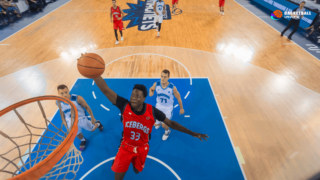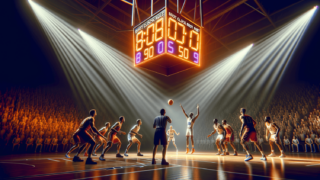
What Is a Baseline in Basketball?
Written by: Basketball Universe
Last updated:

In the exhilarating world of basketball, every inch of the court plays a vital role in the drama that unfolds on game day. In this post, we’ll dive into one of the foundational aspects of the sport that may not always get the limelight it deserves — the baseline. Often underestimated but crucial to the strategic nuances of basketball, the baseline serves as both a physical boundary and a starting point for many exciting plays. So, whether you’re a seasoned pro or just developing your knowledge of the game, come along as we explore the ins and outs of the baseline in basketball, and discover its importance in shaping the captivating experience of this beloved sport.
What Is a Baseline in Basketball?
A baseline in basketball refers to the boundary lines running along the width of the court at each end, marking the space between the inbounds and out-of-bounds areas. It represents a point of reference for several team strategies and plays, such as inbounding the ball or attempting a corner three-pointer. In essence, the baseline helps define the playing area and serves as a crucial component in the overall structure of the game.
Unraveling the Mysteries of the Baseline
If you’ve ever paid close attention to a basketball court, you’ll notice a few lines weaving their way across the court’s surface. However, what may go unnoticed is the very boundary line that typically receives little attention – the baseline, which represents a pivotal part of basketball strategy and gameplay. In this blog, we’re leaving no stone unturned in our quest to unravel the mysteries of the baseline, from strategies to historical tidbits, and beyond.
The Two-Fold Role of the Baseline
The baseline serves a two-fold role within basketball court dimensions: it is both the perimeter that helps define the playing area and a point of reference for various team strategies and tactics. Let’s look at the baseline from these two perspectives.
Defining the Playing Area
As one of the critical elements that outline the bounds of a standard basketball court, the baseline helps form a rectangle measuring 94 feet by 50 feet for professional games. It runs perpendicular to the sidelines—the longer boundary lines on each side of the court—and extends across the court at either end. The inbounds and out-of-bounds regions are demarcated by the sidelines and baselines, with the area inside these lines being the playing area, and anything beyond labeled off-limits. Stepping on or beyond these lines while in possession of the ball will result in a turnover, thus emphasizing the importance of court awareness in basketball.
Key Tactical Component
Apart from defining the physical boundaries of play, the baseline also influences various in-game tactics, like corner three-pointers, baseline cuts, and pivotal inbounding plays. While it may seem like merely a piece of the greater court layout puzzle, the baseline notably impacts teams’ offensive and defensive strategies.
Mastering Baseline Strategies
Those who excel in basketball have one thing in common – they know how to use every inch of the court to their advantage. This section will highlight some of the strategies and tactics that take place near the baseline.
Three-Point Corner Specialist
The corner three-pointer is a staple of basketball, and it’s no accident that shots from this specific spot are so successful. The reason behind it is simple: the three-point line is closest to the basket in the corners. This distance difference, along with a wide-open view of the hoop, has led to some players specializing in corner threes. These specialists lurk along the baseline beyond the arc, waiting for the perfect moment to catch and release a deadly shot. Familiar names such as Ray Allen, Kyle Korver, and Klay Thompson have mastered this art, cementing their legacies as exceptional three-point corner marksmen.
Baseline Cuts
Off-ball movements are crucial to getting open for shots or creating space for teammates. One such off-ball tactic is the baseline cut, in which a player without the ball runs along the baseline to get behind the defense, often resulting in a high-percentage layup or dunk attempt. These cuts can be incorporated in various offensive sets, like the Triangle Offense, and can excel when executed appropriately.
Inbounding Plays
While it’s not rare for fans to overlook the importance of a properly executed inbound pass, elite players understand that inbounding plays can determine the trajectory of a game. Baseline inbounding occurs following a made basket or when the ball has gone out of bounds along the baseline. With only five seconds to pass the ball inbounds without incurring a turnover, these situations require quick thinking, precise execution, and knowledge of various inbound plays. Coaches design specific “baseline out-of-bounds” plays to create open scoring opportunities, potentially turning tight situations into game-changing moments.
A Closer Look at Defensive Tactics
As with any strategic component of basketball, the interplay between offense and defense near the baseline can make or break a competitive matchup. We’ll now shed light on some key defensive tactics employed near the baseline.
Using the Baseline as an Extra Defender
Experienced defenders recognize the baseline as the court’s natural boundary and use it to their advantage. For instance, when defending a player near the baseline, a savvy defender might force their opponent towards it, effectively creating a “double-team” situation. This forces the opposing player into a cramped space, increasing the likelihood of a bad pass, turnover, or contested shot.
Denying Baseline Drives and Cuts
Agile and aware defenders can disrupt an opponent’s offensive strategy by denying baseline cuts or drives. To achieve this, defenders position themselves between their opponent and the basket, forcing them away from the baseline while maintaining proper containment. This prevention technique throws a wrench into the offense’s plans, disrupting their rhythm and generating uncomfortable situations for the attacking team.
Historical and Geographical Influences on the Baseline
While the concept of creating a compelling narrative around the baseline might seem far-fetched, it’s essential to understand how various historical and geographical factors have influenced its prevalence and significance in basketball. In this section, we’ll delve into the sport’s rich history to explore the development of the baseline and its role in determining the distinctive features of basketball courts worldwide.
Baseline Origins: Dr. James Naismith and the First Basketball Game
Though the baseline’s specific roots in basketball are not well documented, we can trace its inception to the sport’s origin in 1891, when Dr. James Naismith nailed a peach basket to the wall of a YMCA gymnasium in Springfield, Massachusetts. In his original 13 rules, Dr. Naismith laid the groundwork for the modern-day basketball court, including the baseline. Peach baskets were soon replaced by nets, but the baseline remained a constant element, evolving over time to the configuration we recognize today.
International Basketball Dimensions: A Baseline Comparison
As basketball spread throughout the globe, countries and leagues adapted the court to their specific needs and facilities. Consequently, baselines (and courts) can vary slightly depending on where you’re playing. In the National Basketball Association (NBA), the court measures 94 feet in length and 50 feet in width, with a baseline spanning 50 feet. However, the International Basketball Federation (FIBA) standards dictate a court length of 91.9 feet and a width of 49.2 feet, resulting in a slightly narrower baseline. Though the differences may seem inconsequential, they do impact the gameplay and strategic nuances of basketball in different leagues.
The Baseline’s Impact on Rule Changes and Adaptations
In a sport that continuously evolves, the baseline has helped shape the game and influence vital rule changes and adaptations. In this segment, we will discuss how the baseline has played a part in molding basketball’s historical trajectory and rule changes.
Passing the Ball Over the Backboard
Originally, it was legal to pass the ball over the backboard from behind the basket during inbounding plays. Since baselines historically had no defined dimensions, teams often attempted to take advantage of inconsistencies by creating undue pressure for defenders. In response, the NCAA and NBA changed the rules to make such passes illegal, ensuring a more balanced competition and preserving the spirit of the game.
The Larry Bird Exception
During a game between the Boston Celtics and the Detroit Pistons in the 1987 NBA Playoffs, the legendary Larry Bird exploited a gray area in the rulebook that forever changed the game. Bird inbounded a long pass over the backboard to Kevin McHale, leading to a key three-point play. While the referees allowed the play to proceed, the NBA later ruled it illegal, amending the rulebook and closing the loophole. This peculiar incident involving the baseline highlighted the need for clearer rules defining what is and isn’t permissible in basketball.
Appreciating the Baseline in Basketball
Despite not often featuring in the spotlight, the baseline holds a unique position within the world of basketball. It serves as a physical boundary marker that defines the playing area yet maintains an essential role in shaping team strategies and tactics. By appreciating every aspect of the game, from the most obscure rules to the critical lines on the court, we can deepen our understanding and love for this dynamic and captivating sport.
Beyond the Court: How the Baseline Inspires Creativity and Innovation
The baseline’s influence extends beyond the strategic realm of basketball; it has also inspired creativity and novel approaches in coaching, athletic performance, and even fan experiences. This section examines how the baseline has generated innovation and out-of-the-box thinking in the sport.
Baseline Drills for Skill Development
Coaches and trainers often design specific drills around the baseline to help players develop their skills and excel in game situations. These baseline-centric exercises can range from fundamental dribbling and agility workouts to advanced shooting and cutting drills, all devised to make players feel more comfortable and adept at using the court’s boundaries. A deeper understanding of baseline dynamics can help athletes perform better under pressure and leverage the baseline to their advantage.
Baseline Camera Perspectives: Enhancing the Fan Experience
With basketball’s ever-growing global fan base, media organizations and sports leagues continuously explore innovative ways to capture and broadcast gameplay. This includes placing cameras on the baseline, giving fans a broader view of the action, particularly around the hoop. Baseline cameras offer a unique perspective of both offensive and defensive maneuvers, providing audiences an enriched understanding and appreciation of the sport’s intricate nuances.
Aesthetics: Baseline Art and the Influence on Court Design
Basketball court designers have experimented with various artistic elements, often drawing inspiration from the geometric features of the court, including the baseline. Incorporating visual elements, team logos, and even abstract patterns across the baseline has led to more engaging and vibrant court designs. This trend showcases how a seemingly simple line can ignite creativity in spaces that are typically overlooked.
Baseline Trivia: Fun and Quirky Facts on the Court
What’s an in-depth exploration of basketball without a few fun facts and quirky trivia? In this section, we’ll share some amusing anecdotes and tidbits associated with the baseline and its impact on the sport.
Famous Baseline Buzzer-beaters
There’s nothing quite as thrilling as a buzzer-beater that leaves a stadium roaring with excitement. Some of the most memorable last-second heroics in basketball history have taken place along the baseline, demonstrating how iconic moments can stem from seemingly unassuming court sections. From Michael Jordan’s series-winning jumper against Cleveland in 1989 to Damian Lillard’s cold-blooded shot against Oklahoma City in 2019, the baseline has played a part in creating indelible memories.
The Baseline as a Canvas for Signature Celebrations
Throughout the sport’s history, players have utilized the baseline as a stage for showcasing their unique personalities and bringing unrivaled joy to basketball arenas. From Allen Iverson stepping over Tyronn Lue following a baseline jumper in the 2001 NBA Finals to LeBron James’ infectious bench celebrations during blowout wins, the baseline has often played host to fan-favorite moments.
As we’ve explored in this comprehensive guide, the baseline holds a critical and multifaceted role within the sport of basketball. Understanding the baseline’s significance allows us to better appreciate the game’s intricacies and the array of strategic maneuvers taking place on the court. Whether you’re just starting your basketball journey or assembling your coaching playbook, remembering the importance of the baseline will undoubtedly enrich your connection to this remarkable sport.
Frequently Asked Questions (FAQs)
If you’re excited to learn even more about the baseline in basketball, look no further! We’ve compiled a list of common questions and concise NLP-style answers to provide you with additional insights into this fascinating topic. Let’s traverse the baseline’s various dimensions as we delve into these FAQs.
How wide is the baseline in basketball?
In the NBA, the baseline is 50 feet wide, while FIBA regulation courts have a baseline width of 49.2 feet.
Is it easier to shoot three-pointers from the baseline?
Yes, corner three-pointers near the baseline are generally easier due to the shorter distance between the three-point line and the basket in these areas.
What is a baseline drive in basketball?
A baseline drive is an offensive maneuver where a player dribbles along the baseline to attack the basket, typically aiming to score or create an open shot opportunity for a teammate.
What is a baseline inbounds pass?
A baseline inbounds pass occurs when a player passes the ball from behind the baseline to a teammate on the court, usually after the ball has gone out of bounds or following a made basket by the opposing team.
Do basketball courts always have the same baseline size?
No, basketball courts can vary in size, particularly between different leagues and levels of play. However, NBA and FIBA courts both have standardized baseline dimensions.
When do players need to be aware of the baseline during a basketball game?
Players must be aware of the baseline to avoid stepping out of bounds, to effectively execute baseline strategies, and to defensively exploit the confinement created by the baseline.
Why do some basketball players specialize in shooting from the baseline?
Some players specialize in baseline shooting due to the higher percentage shots it can offer, particularly for corner three-pointers, and the strategic value it brings to the team’s offensive flow.
Can a player jump from behind the baseline to inbound the ball?
Yes, players are allowed to jump from behind the baseline while inbounding the ball, as long as they release the pass before making contact with the playing area.
What are some famous buzzer-beaters that occurred on the baseline?
Memorable baseline buzzer-beaters include Michael Jordan’s series-winning shot against Cleveland in 1989 and Damian Lillard’s game-winner against Oklahoma City in 2019.
Can a player stand on the baseline while attempting a shot?
Yes, players can stand on the baseline during a shot attempt, as long as they do not step on or beyond the line, which would make them out of bounds.
How is the baseline used to create defensive pressure?
Defenders can use the baseline to create pressure by forcing offensive players towards it, limiting the space available for dribbling and passing, and increasing the risk of turnovers or bad passes.
Why do players make baseline cuts?
Baseline cuts are made to get behind the defense, create open shot opportunities, and facilitate ball movement as part of offensive sets such as the Triangle Offense.
Has the baseline played a role in rule changes throughout basketball history?
Yes, the baseline has influenced rule changes and adaptations, such as passing the ball over the backboard being deemed illegal and amendments following Larry Bird’s infamous inbound pass over the backboard.
Featured Posts
- No pillar pages found.




